We want to create a healthy habitat for people, pets, and wildlife. Avoiding chemicals is part of our efforts.
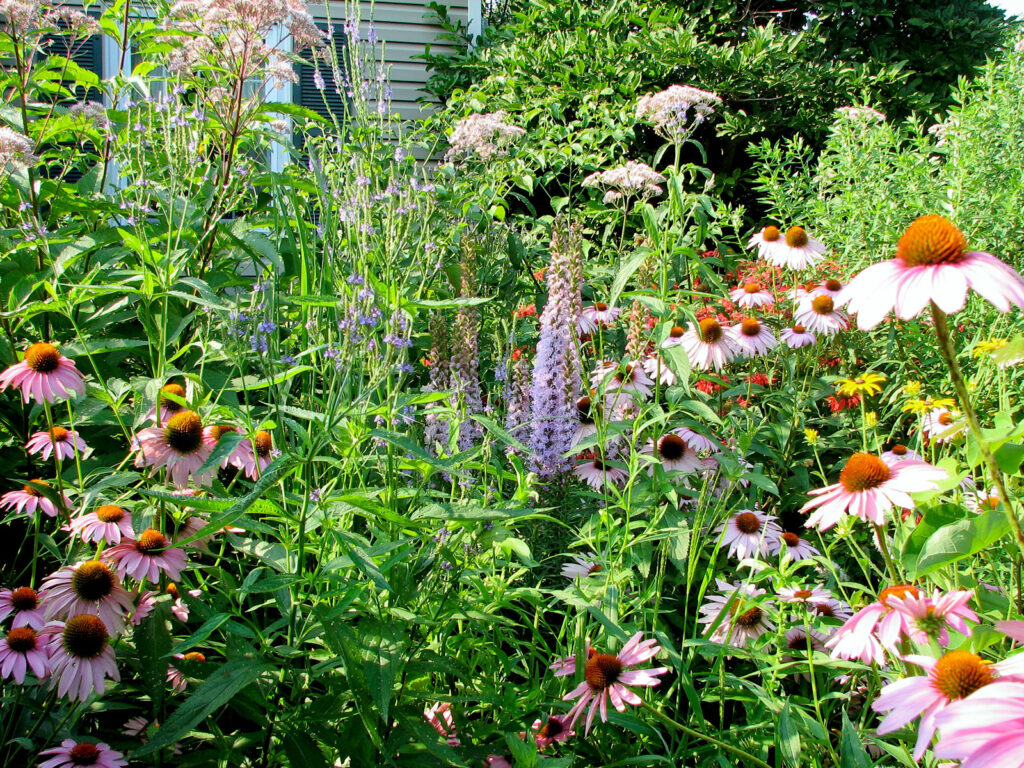
For many years now, we’ve grown fruit and vegetables in our edible garden, had flower beds full of flowers, and have thriving lawn and shrubs — all without using chemical fertilizers, pesticides, or herbicides. We focus instead on maintaining healthy soil.
Besides the fact that our experience shows that these chemicals are unnecessary, research (see Resources below) indicates they’re dangerous for children, pets, and wildlife.
And here are our alternatives to pesticides.
Yard chemicals and children
Our grandchildren can’t yet appreciate a pesticide-free yard, but we feel good about providing a safe, healthy place for them to play when they visit. And what’s more, we’re protecting the health of all our community’s children.
There’s enough evidence of harm to children — they’re poisons including neurotoxins, after all — that not using these chemicals is the prudent thing to do.
[NOTE: A few years ago, this photo was selected as a monthly photo on the Beyond Pesticides calendar!]
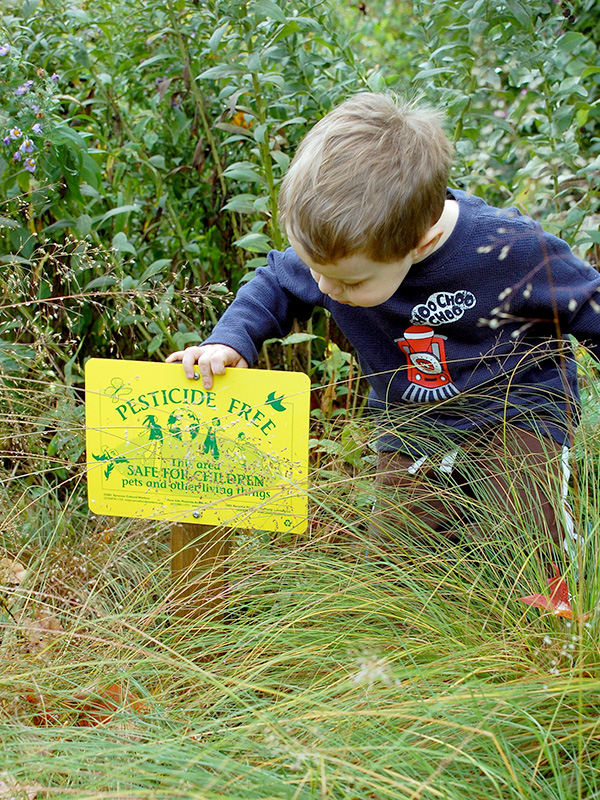
How could having a perfect lawn be worth even one child in our community being sickened by these chemicals or whose development is harmed?
I’m constantly amazed that people consider a perfect lawn worth the risk to our children’s health! I guess kids will have to be dropping dead at their feet before they’ll stop using these poisons.
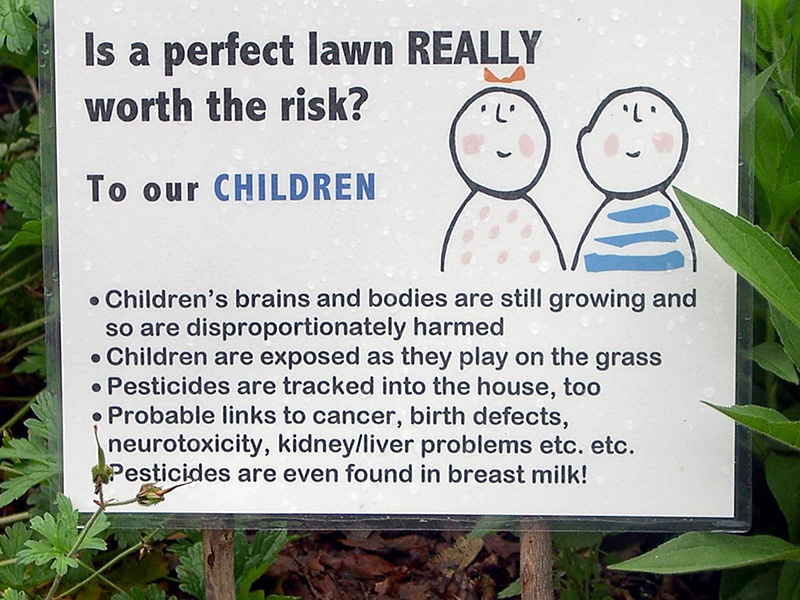
Ironically, adults (except for pesticide applicators) reap the “benefits” of having a beautiful lawn, while children take all the risks.
Children are at risk because their smaller, still-developing bodies and brains are disproportionately affected by these chemicals.
And there’s special concern about dangers about prenatal exposure. What expectant mother doesn’t worry about the many toxic chemicals in our environment? Lawn chemicals are some of the easier products to eliminate, at least in our own yards.
It will always be difficult to have 100% proof that any given pesticide is harmful, a fact that chemical companies rely on to create doubt about the dangers of their products. After all, we could never ethically compare groups of children who were and were not exposed to pesticides — the only way to provide the kind of proof they require. (And at this point do we truly believe that if a chemical has been government-approved it means it’s safe?)
Common sense tells us to use the Precautionary Principle, as much of Europe does (see Alternatives for a definition of this concept). In fact, many other countries ban some of the chemicals EPA has approved for this country. Hmmm… could someone be getting rich from selling these products?
As Sandra Steingraber says, “The benefit of the doubt goes to children, not chemicals!” (I highly recommend her books – see Resources below.)
Yard chemicals and pets
It’s hard to believe that even while we were using lawn chemicals, we let our dog lie on the grass, believing the lawn company’s signs saying it was safe after 24 hours! She was further exposed to these chemicals in the neighborhood when we took her on walks.
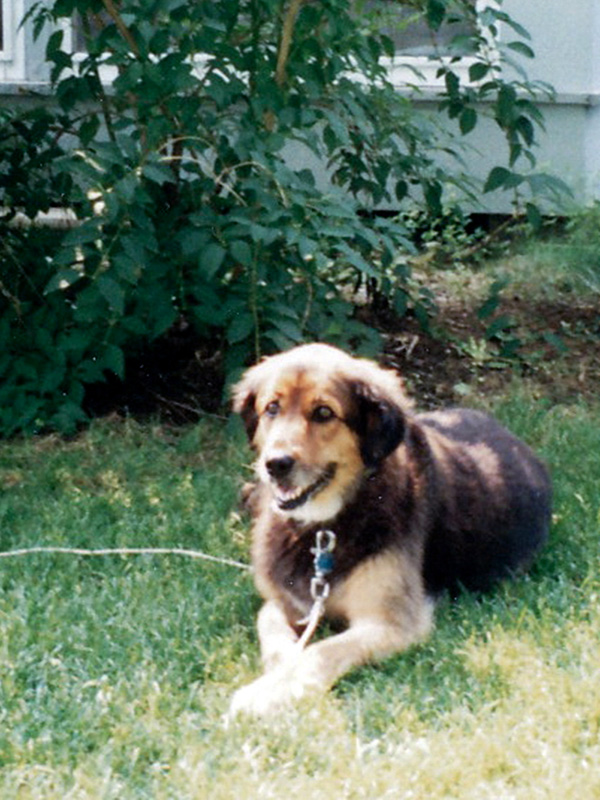
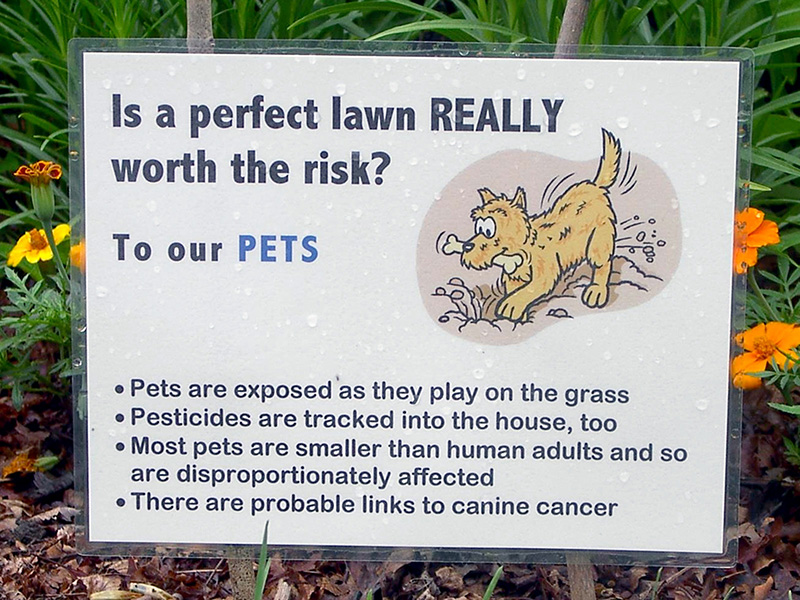
Research (see Resources below) has since found increased risks of cancer among dogs related to lawn and garden chemicals.
And sadly, as it happens, Sheena did die of canine cancer.
Yard chemicals and wildlife
We always plant lots of parsley (as well as other larval host plants) in the hopes of attracting a beautiful black swallowtail to lay her eggs. Imagine our dismay when we saw one well-known garden catalog advertise a product called Caterpillar Killer as a “safer” way of killing “parsley worms” — parsley worms being the caterpillars of the beautiful black swallowtail butterfly!
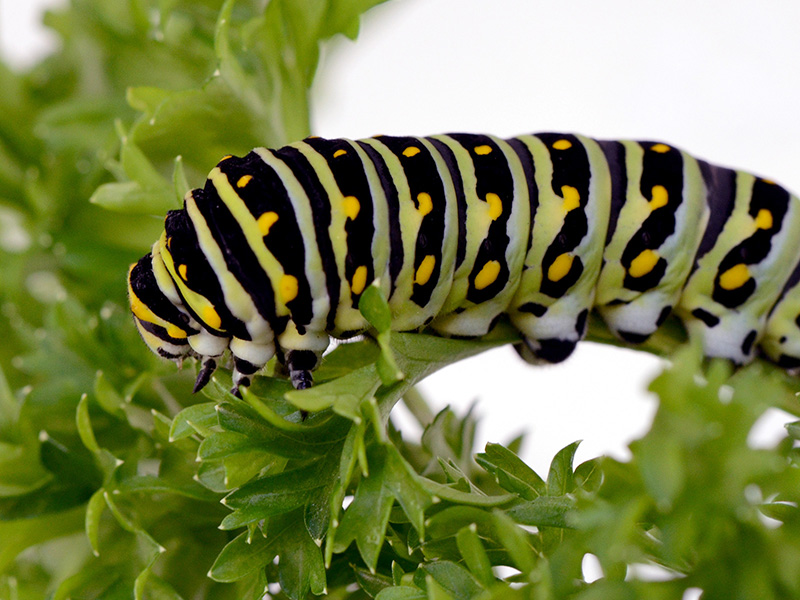
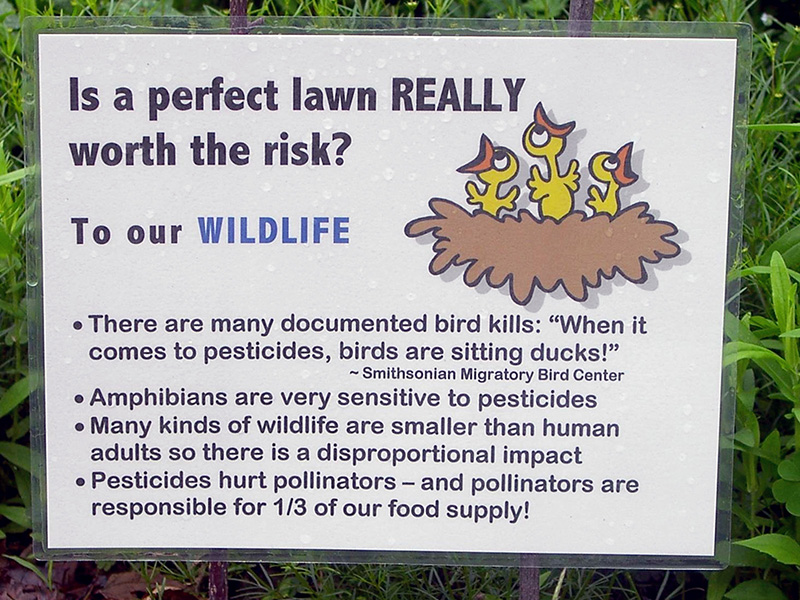
Other butterflies, bees, birds, amphibians, and other wildlife are dramatically affected either acutely resulting in immediate death, or chronically resulting in reduced vigor or associated consequences, such as gender change in frogs.
Although I can’t be sure of the cause, this bee was acting as if it had been poisoned by pesticides — unfortunately a plausible explanation considering the amount of pesticides applied in our neighborhood.
And with the population of bees in decline, it’s not only sad, but alarming. Pesticide use is one of the reasons pollinators are in decline.
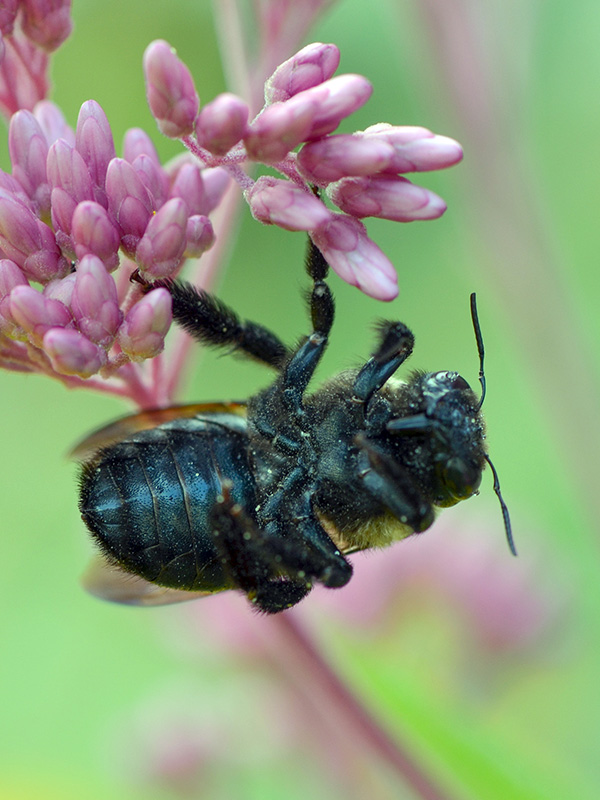
As the Smithsonian Migratory Bird Center says, “When it comes to pesticides, birds are sitting ducks”!
Pesticides kill millions of birds outright, and they also cause sub-lethal effects that cause health problems for birds.
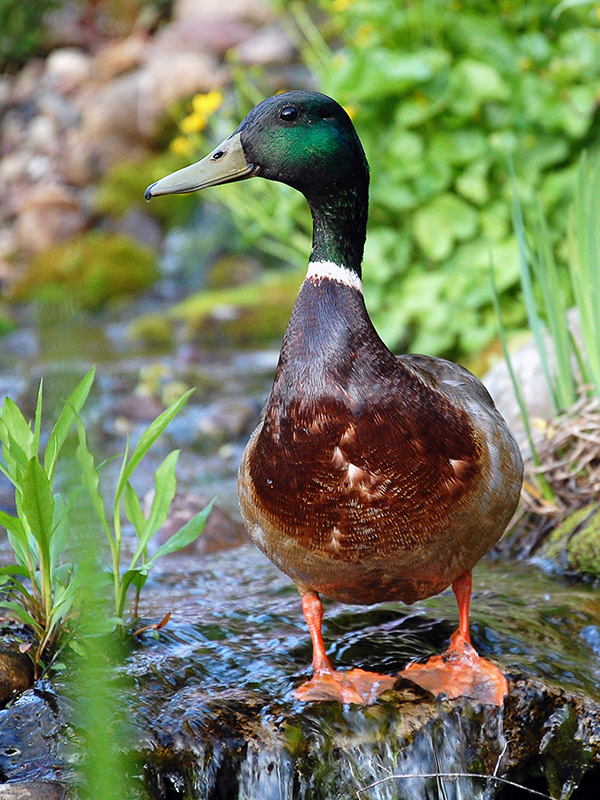
Lawn signs
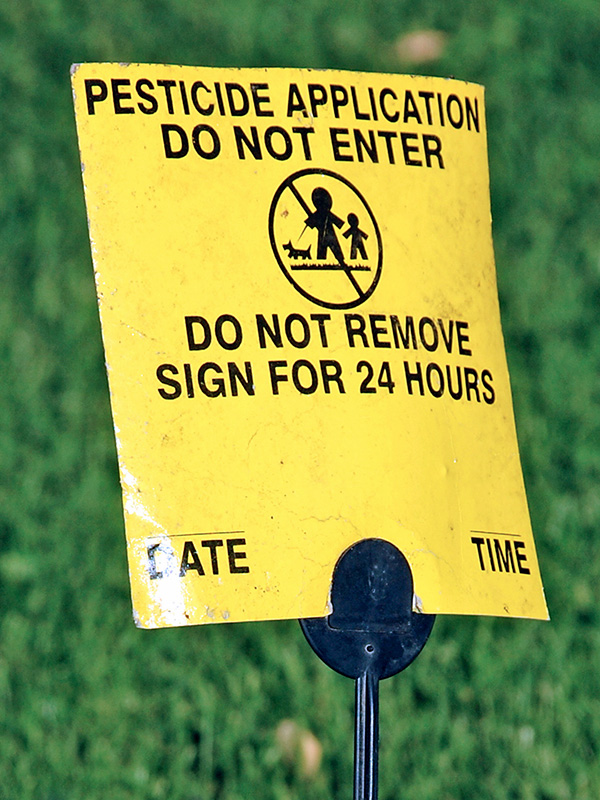
Commercial applicators in our community are required to display a sign saying that pesticide has been applied. (Technically, I believe homeowners are required to also, but nobody enforces it.)
How could anyone feel good about having their yard turned into a toxic environment even for 24 hours? Just like reading the warning on cigarette packs would deter me from smoking, seeing this little sign would make me want to avoid it.
(These signs weren’t required years ago when we applied these chemicals.)
A few years ago I heard a local environmental toxicologist from Upstate Medical Center say that these poisons in fact do NOT degrade in 24 hours, despite what the little yellow signs say. And signs don’t protect kids or pets from the pesticide residues tracked into the house even during the first 24 hours. And where do kids and pets play? On the floor of course!
We wanted to display a more useful message, so we purchased some signs and created other pesticide-free signs.
IMPORTANT: The chemicals in the pesticides and herbicides mentioned in the resources below are the “ingredients” contained in commercial products with more-familiar and less-menacing names, such as “Weed ‘n Feed.”
Resources
- Scientific American:
- Xerces Society:
- Center for Food Safety:
- Bee-toxic pesticides to avoid – You may be using neonics and not realize it!
- Consumer Reports:
- A lush lawn without pesticides – and in May 2021 issue of CR
- NRDC (Natural Resources Defense Council):
- Rodale’s Organic Life:
- Your body on RoundUp – The weed killer seems to find its way into just about anything
- Choose Natives:
- Univ. of New Hampshire Extension:
- Univ. of Wisconsin:
- Should parents be concerned about kids and lawn chemicals? (yes!)
- Sandra Steingraber:
- BOOKS: As a biologist, Steingraber’s three books are grounded in science: Living Downstream, Having Faith, and Raising Elijah. Steingraber is also the subject of the documentary Living Downstream.
- Pollinator Pathways:
- Civil Eats:
- Grist:
- Smithsonian Migratory Bird Center:
- American Bird Conservancy:
- Cornell All About Birds:
- Humane Gardener:
- Beyond Pesticides:
- Tools for Change – How to organize communities
- Study connects neonicotinoids to liver damage
- New evidence shows RoundUp damages the nervous system
- Corruption problems persist at the EPA
- Research shows adverse impacts of glyphosate on the human gut microbiome
- 4 out of 5 people in the US contaminated with glyphosate
- Common herbicide contributes to inflammatory bowel disease
- Disease-carrying mosquitoes developing resistance to mosquito control pesticides
- Banned pesticides still present in environment linked to hearing loss
- Neonicotinoid insecticide exposure harms amphibians across multiple life stages
- Insects in nature preserves contaminated with over a dozen pesticides
- Monsanto/Bayer claims of glyphosate safety not supported by credible science
- Children’s exposure to mosquito pesticides increases risk of respiratory disease
- Glyphosate weed killer disrupts bumblebees’ nest temperature leading to colony failure
- Trouble for Bambi: Neonic levels in wild deer spiking
- Health effects of 40 commonly used lawn pesticides
- Environmental effects of 40 commonly used lawn pesticides
- Pesticides and children don’t mix
- Insecticide chlorpyrifos interacts with genes to increase autism risk
- Global chemical pollution exceeds safe limits for humanity
- France enacts sweeping restriction on pesticide use on public and private landscapes
- Pesticides and Parkinson’s Disease: The toxic effects of pesticides on the brain
- Environmental Working Group:
- The Great Healthy Yard Project:
- Their goal is to have people pledge to not use pesticides to protect our drinking water.
- American Academy of Pediatrics:
- Pesticide Action Network:
- CBS This Morning:
- National Academy of Sciences:
- In-utero pesticide exposure linked to brain abnormalities – Chlorpyrifos is the generic name for a common pesticide (e.g. brand names Dursban, Paqeant, Scout etc.)
Reflections
Do unto those downstream as you would have those upstream do unto you.
~ Wendell Berry
More than 15% of all suspected dog poisonings reported to the Animal Poison Control Center between 2005 and 2014 involved lawn and garden chemicals…
~ Consumer Reports (7/21)
We should no longer accept the counsel of those who tell us that we must fill our world with poisonous chemicals; we should look about and see what other course is open to us.
~ Rachel Carson, Silent Spring
I believe that our grandchildren will look back on us now and marvel that our economy was once dependent on chemicals that were killing the planet and killing ourselves and they will think of it as unthinkable.
~ Sandra Steingraber
It’s not the aphids, white flies, beetles, and mealybugs we need to be most afraid of. It’s the shortsightedness of our own species. As we’ve already learned from painful experience, if we ignore the longer view — and forsake the only home we have in the name of profit and so-called convenience — it will likely be too late.
~ Nancy Lawson, The Humane Gardener
In fact, insects are evolving resistance to chemicals just about as fast as we humans can devise new ones. Perhaps the greatest of all celestial ironies is being played out. As we increasingly risk our own health in a war of toxic terror — a process of unnatural selection — we are encouraging insects to become ever more dominant life-forms.
~ Eris Grissell, Insects and Gardens, p. 115
Regarding spraying for mosquitoes:
Fireflies, butterflies and bees are just as likely as mosquitoes to encounter fine drops of insecticide in the air or on foliage treated with barrier sprays. Treated foliage is toxic to adult insects that land on it and any insects that eat it.
~ Karen Oberhauser
Chris Jordan: Roundup – an artistic reflection on chemical pesticides (be sure to click on the photo to zoom in!) His entire website is worth perusing.
